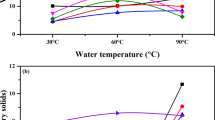Abstract
Pea pod shells, which account for 30–40% of fresh green peas weight and form major waste in pea industry were blanched and dehydrated. Analysis revealed a nutritious, sweet, fibrous material with potential for use as ingredient for functionalizing popular foods. The pea pod powder (PPP) was incorporated in eggless, low fat mayonnaise with the objective of enriching it with dietary fibre and micronutrients. Inclusion of PPP in mayonnaise led to better sensory attributes which corroborated with rheological and textural parameters. Droplet distribution and higher hysteresis area and consistency coefficients results indicated beneficial effect of PPP on emulsion stability. The tribological profile investigation clearly revealed distinct sensory profile amongst samples correlating with sensory acceptance. Higher activation energy and heat stability index demonstrated higher stability of emulsions in the presence of PPP.








Similar content being viewed by others
References
FAO. https://www.fao.org/faostat/en/#data/QC/visualize. Accessed 26 Dec. 2019
I. Mateos-Aparicio, A. Redondo-Cuenca, V. María-José, Z. María-Aurora, T. María-Dolores, Food Sci. Technol. (2010). https://doi.org/10.1016/j.lwt.2010.05.008
L. Huang, T. Wang, Z. Han, Y. Meng, X. Lu, Food Hydrocolloids (2016). https://doi.org/10.1016/j.foodhyd.2015.12.027
S. Thaiudom, K. Khantarat, Proc. Food. Sci. (2011). https://doi.org/10.1016/j.profoo.2011.09.049
D.R. Izidoro, A.P. Scheer, M.R. Sierakowski, C.W. Haminiuk, LWT-Food Sci. Technol. (2008). https://doi.org/10.1016/j.lwt.2007.07.009
L. Bai, S. Huan, Z. Li, Food Hydrocolloids (2016). https://doi.org/10.1016/j.foodhyd.2016.12.019
V. Raikos, A. McDonagh, G. Duthie, Food Sci. Hum. Wellness (2016). https://doi.org/10.1016/j.fshw.2016.10.002
S. Fujihara, A. Kasuga, Y. Aoyagi, J. Food Sci. (2001). https://doi.org/10.1111/j.1365-2621.2001.tb16119.x
S.O. Agunbiade, O.J. Ojezele, A.M. Eze, Chem. Int 24, 92–96 (2017)
E. Manolopoulou, T. Varzakas, Curr. Res. Nutr. Food Sci. 4, 10–17 (2016). https://doi.org/10.12944/CRNFSJ.4.Special-Issue-October.02
J. Bouzas, C.A. Kantt, F. Bodyfelt, J.A. Torres, J. Food Sci. 56, 276–278 (1991). https://doi.org/10.1111/j.1365-2621.1991.tb08034.x
V. Nikzade, M. Saadatmand-Tarzjan, Food Hydrocolloids (2012). https://doi.org/10.1016/j.foodhyd.2011.12.023
H. Liu, X.M. Xu, S.D. Guo, LWT-Food Sci. Technol. (2007). https://doi.org/10.1016/j.lwt.2006.11.007
N. Singla, P. Verma, G. Ghoshal, S. Basu, Int. Food Res. J. 20, 1–2 (2013)
S.G. Rudra, P. Nath, C. Kaur, S. Basu, J. Food Process. Preserv. (2016). https://doi.org/10.1111/jfpp.13067
R. Santipanichwong, M. Suphantharika, Food Hydrocolloids (2009). https://doi.org/10.1016/j.foodhyd.2008.10.006
M. Garg, J. Food Process. Technol. (2015). https://doi.org/10.4172/2157-7110.1000522
C.S. Brennan, L.J. Cleary, Food Res. Int. (2007). https://doi.org/10.1016/j.foodres.2006.09.014
C. Chang, J. Li, X. Li, C. Wang, B. Zhou, Y. Yang, LWT-Food Sci. Technol. (2017). https://doi.org/10.1016/j.lwt.2017.04.013
S. Mun, Y.L. Kim, C.G. Kang, K.H. Park, J.Y. Shim, Y.R. Kim, Int. J. Biol. Macromol. (2009). https://doi.org/10.1016/j.ijbiomac.2009.02.008
O. Ketenoglu, B. Mert, A. Tekin, J. Texture Stud. (2014). https://doi.org/10.1111/jtxs.12074
S. Worrasinchai, M. Suphantharika, P. Jamnong, Food Hydrocolloids (2006). https://doi.org/10.1016/j.foodhyd.2005.03.005
H. Miyamoto, D.M. Rein, K. Ueda, C. Yamane, Y. Cohen, Cellulose (2017). https://doi.org/10.1007/s10570-017-1290-1
N. Selway, J.R. Stokes, Food Res. Int. (2013). https://doi.org/10.1016/j.foodres.2013.07.044
I. Martinez, M.A. Riscardo, J.M. Franco, J. Food Eng. (2007). https://doi.org/10.1016/j.jfoodeng.2006.09.022
S.H. Ching, N. Bansal, B. Bhandari, Food Res. Int. (2016). https://doi.org/10.1016/j.foodres.2015.12.016
M. Aslanzadeh, M. Mizani, A. Gerami, J. Food Technol. Nutr. 11, 10–24 (2014)
J.R. Stokes, M.R. Boehm, S.K. Baier, Curr. Opin. Colloid Interface Sci. (2013). https://doi.org/10.1016/j.cocis.2013.04.010
J. R. Stokes, A. Ferndanez, H. Nieves, W. J. Mattsson, D. A. Weitz (Eds.), Microgel Suspensions, Wiley, Weinheim (2011)
S. Różańska, In J Ahmed (ed.). Advances in Food Rheology and Its Applications. (Woodhead Publishers, 2017). https://doi.org/10.1016/B978-0-08-100431-9.00006-1
E.M. Krop, M.M. Hetherington, M. Holmes, S. Miquel, Food Hydrocolloids (2019). https://doi.org/10.1016/j.foodhyd.2018.09.040
L. Laguna, A. Sarkar, Tribol.-Mater. (2017). https://doi.org/10.1080/17515831.2017.1347736
C.M. Steele, P. Van Leishout, J. Speech (2009). https://doi.org/10.1044/1092-4388(2009/08-0131)
F.C. Godoi, B.R. Bhandari, S. Prakash, Food Hydrocolloids (2017). https://doi.org/10.1016/j.foodhyd.2017.04.011
T. K. Koh, S. Singh. Stable emulsions with dietary fibre. (Chemical Today Magazine, 2015). https://medium.com/@worldofchemical. Accessed 14 September 2019
Acknowledgements
We acknowledge the support of AshaRam and Sons and Novotech Food Ingredients for providing ingredients; Dr. Gautam Chawla, IARI for conducting the microscopic examination and Ms. Deepika from Anton-paar, New Delhi for conducting the tribological experiments.
Author information
Authors and Affiliations
Corresponding author
Additional information
Publisher's Note
Springer Nature remains neutral with regard to jurisdictional claims in published maps and institutional affiliations.
Electronic supplementary material
Below is the link to the electronic supplementary material.
Rights and permissions
About this article
Cite this article
Rudra, S.G., Hanan, E., Sagar, V.R. et al. Manufacturing of mayonnaise with pea pod powder as a functional ingredient. Food Measure 14, 2402–2413 (2020). https://doi.org/10.1007/s11694-020-00487-0
Received:
Accepted:
Published:
Issue Date:
DOI: https://doi.org/10.1007/s11694-020-00487-0




